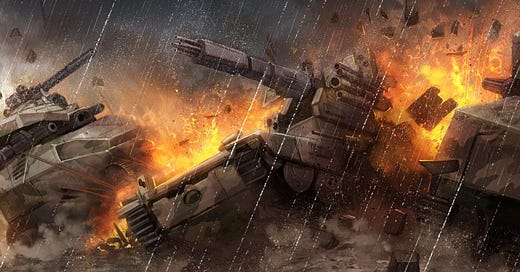The U.S. Army Created a Comic Book About Being Attacked by Russian Robo-Tanks
'Silent Ruin,' from the Army Cyber Institute at West Point, continued a long graphic tradition
This story originally appeared in Vice.
Russian military drones launch a devastating electronic attack, disabling American defenses. A tiny force of U.S. Army tanks succumbs to an overwhelming robotic onslaught. Victorious Russian troops besiege an American embassy.
That’s the premise of the 2018 short comic, “Silent Ruin,” from the Army Cyber Institute at West Point, the U.S. Army's main officer-training academy. “Silent Ruin” is the latest in a long run of official military comics. Some are simple training aids for weapons maintenance. This one aims to predict the future of warfare.
According to a disclaimer, “Silent Ruin” doesn’t represent official government policy. But the Cyber Institute did intend for the five-page comic to be realistic, plausible and motivating.
“Our story does not shy away from a dystopian vision of tomorrow,” Lt. Col. Natalie Vanatta states in the foreword. “Exploring these dark regions inspires us to build a better, stronger and more secure future for our armed forces. Our goal is to encourage individual action and motivate new explorations and research.”
The story is set in 2027. Romania and Moldova have united, provoking a powerful response from nearby Russia. “Tensions are high as both NATO and Russia conduct training missions on each side of the border,” the comic explains. “When both forces’ front-line autonomous forces deviate from their submitted plans … the robots engage … triggering a full conflict.”
Russian aerial drones initiate the attack, activating unspecified electronic devices that cause U.S. surveillance drones to crash. Two U.S. Army M-1 tanks, each commanding several robotic wingmen, go to investigate. The Russians exploit a flaw in the M-1s’ software, essentially hijacking the tanks from their four-person crews. Russian forces cause one tank to flip over into a river—and send robotic vehicles to destroy the other with cannon fire.
The tanks’ destruction leaves the capital defenseless to marauding enemy troops. The comic ends on an ominous notes as “Russian forces converge on the U.S. consulate.”
“The scenario of Russia trying to bully its neighbors and U.S. troops finding themselves ill-prepared for the opening battle of a war are unfortunately all too realistic,” Peter W. Singer, a military analyst and author of the technothriller Ghost Fleet, told me.
Russia invaded Georgia in 2008, seized Ukraine’s Crimea region in 2014 and widened its war on Ukraine in 2022. Moscow has also interfered in elections in the United States and across Europe.
Meanwhile, the Kremlin is working hard to develop electronic jammers, hacking tools and autonomous fighting vehicles that could give it an advantage in future warfare.
In 2009, the U.S. Army ended, on cost grounds, its own ambitious program to field unmanned tanks. Busy battling low-tech insurgents in Afghanistan, Iraq and Syria, the Army admitted in 2017 that it was guilty of “25 years of inattention” toward its electronic-warfare capabilities.
“Silent Ruin” depicts one possible result of that mismatch between U.S. and Russian weapons-development. “Fiction can be a powerful tool for better grasping realities,” Singer explained. “It allows you to explore ‘what if’s’ from trends in play, connect with the human and emotional side that is so resonant in both storytelling and the real world, as well as reach a wider set of readers than a memorandum.”
The U.S. military has long viewed comics as a useful medium for communicating complex ideas. The Army for decades published weapons-maintenance tutorials in the form of simple comics. During the Vietnam War, legendary comics artist Will Eisner drew a graphic handbook for Army’s then-new M-16 rifle.
More recently, the Navy published a graphic novel about front-line combat in an effort to introduce medics to the realities of treating battlefield injuries. “Silent Ruin” continues that graphic tradition.
The Cyber Institute hopes the comic will inspire young Army officers to find ways of preventing the scenario the comic depicts. “While we may be reluctant to implement autonomous capabilities, there is no doubt our adversaries will take every opportunity to outpace us,” Lt. Col. J. Lane writes in the afterword.
“If we fail to harden our own systems while they develop innovative means to counter the proliferation of advanced autonomous systems,” Lane continues, “this threatens to render the world’s most technologically advanced force its most vulnerable.”
Read more:
'It's Going to Be Okay'
This short story originally appeared in Vice. None of our robots have faces, per se, but it's not hard to tell how they feel. Body language. Today the medics dragged in one of their own—one of the medical battalion Bears. You know the Bears. Big ol’ things. Fat torso. Tank treads. Curved arms.






